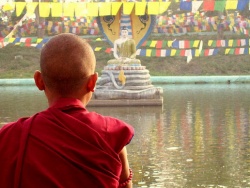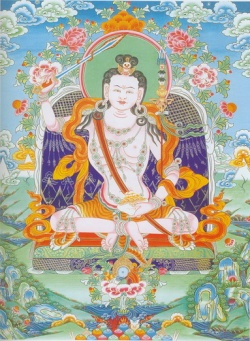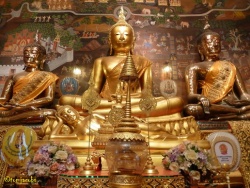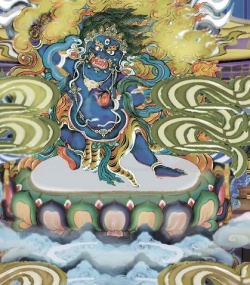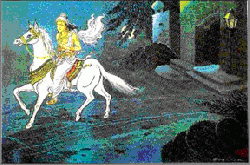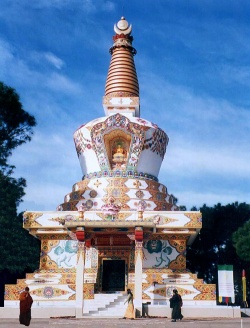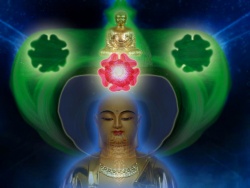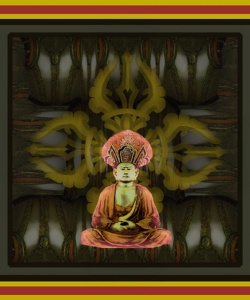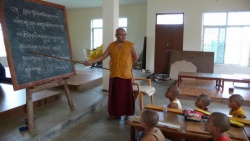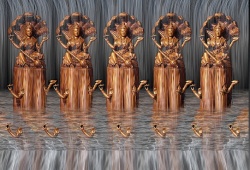Scythic and Non-Aryan Influences
About 126 B.C. the Tartar tribe of Su is said to have driven out the Greek dynasty from Bactria, and the Graeco-Bactrian settlements in the Punjab were overthrown by the Tue-VChi.6 The Scythian migrations towards India culminated in the empire of Kanishka, who held the fourth Buddhist council, circa 40 A.D., and practically became the royal founder of northern Buddhism. The Scythic element played an important part in the history of northern India. Under Kanishka and his successors a connexion was established with the Buddhist nations of central and eastern Asia, traces of which survived to the time of Hwen Tsang (629-645 A.D.) in the name of China-pati, about 10 miles to the west of the Beas river.7 China-pati, is said to have been the town which Kanishka appointed for the residence of his Chinese hostages. It has been suggested that the Aswamedha, or great horse sacrifice, in some of its Indian developments at any rate, was based upon Scythic ideas. "It was in effect," writes Mr Edward Thomas, " a martial challenge, which consisted in letting the victim who was to crown the imperial triumph at the year’s end go free to wander at will over the face of the earth, its sponsor being bound to follow its hoofs, and to conquer or conciliate" the chiefs through whose territories is passed. Such a prototype seems to him to shadow forth the life of the Central Asia communities of the horseman class, "among whom a steed captured in hostile forays has so frequently to be traced from camp, and surrendered or fought for at last."1
An effort has been made to trace Buddha himself to a Scythic origin. He belonged to a royal stock of Sákyas; and the Chinese records supply an intermediate link between his birthplace in Bengal and the supposed home of his race in Central Asia. It is inferred from them that a branch of the Scythian hordes who overran western Asia about 625 B.C. made its way to Patala on the Indus, the site selected by Alexander in 325 B.C. for his headquarters in that delta, and still the capital of Sind under the name of Hyderabad. One portion of these Patala Sycthians went westwards by the Persian Gulf to Assyria; another section eventually moved north-east into the Gangetic valley, and became the Sákyas of Kapilavastu, among whom Buddha was born.2His dying command, that he should be buried according to the old custom of his race, and a mound erected over his remains, is opposed to the Indo-Aryan form of obsequies by cremation; but it is essentially in accord with the Scythian mode of disposing of the dead. In the topes or funeral mounds of Buddhism is seen a reproduction of the royal Scythian tombs of which Herodotus speaks.3It is therefore argued that the Christian fathers trace back, by no accident, the Manichean doctrine to one "Scythianus," whose discipline Terebinthus took the name of Buddha.4
Whatever may be the value of this conjecture, the influence of the Scythian dynasties in northern India is an historical fact. The northern or Tobetan form of Buddhism, represented by Kanishka and his council in 40 A.D., made its way down to the plains of Hindustán, and during the next six centuries competed with the earlier Buddhism of Asoka. The Chinese pilgrim in 629-645 A.D. found both the northern or Scythic and the southern forms of Buddhism in full vigour in India. He spent fourteen months at China-pati, the town where Kanishka had kept his Chinese hostages in the Punjab; and he records the debates between the northern and southern sects of Buddhists in Oudh, Behar, Káthiáwár, and at other places. The Scythic influence in India was a dynastic as well as a religious one. The evidence of coins and the names of Indian tribes of reigning families, such as the Sákas, Huns, and Nágas, point to Scythian settlements as far south as the Central Provinces.5
Many scholars believe that the Scythians poured down upon India in such masses as to supplant the previous populations. The Kits or Játs,6 who form nearly one-half of the inhabitants of the Punjab, are identified with the Getae; their great subdivision the Dhe, with the Dahae, whom Strabo places on the shores of the Caspian. This view has received the support of most eminent investigators, from Professor H.H. Wilson to General Cunningham, the director-general of the archaeological survey.7 The existing division between the Eastern Játs and the Dhe has, indeed, been traced back to the contiguity of the Massa-getae or Great Getae 8 and the Dahae, who dwelt by the side of each other in Central Asia, and who may have advanced together during the great Scythian movement towards India on the decline of the Bactrian empire. Without pressing such identifications to closely in the service of particular theories, the weight of authority is in favour of a Scythian origin for this most numerous and most industrious section of the population of the Punjab.9 A similar descent has been assigned to certain of the Rájput tribes. Colonel Tod, still the standard historian of Rájásthán, strongly insisted on this point. Some relationship between the Játs and the Rájputs, although obscure, is acknowledge; and, although the jus connubii no longer exists between them, an inscription shows that they intermarried in the 5th century A.D.10 Professor Cowell, indeed, regarded the arguments for the Scythic descent of the Rájputs as inconclusive.11 But the whole evidence now collected was not before him; and authorities of great weight have deduced alike form local investigation12 and from Sanskrit literature13 a Scythic origin for the Játs, and for some at least of the Rájput tribes. We shall see that the Scythian hordes also supplied certain of the Non-Aryan or so-called aboriginal races of India.
The Scythic settlement was not effected without a struggle. As Chandra Gupta advanced from the Gangetic valley, and rolled back the tide of Graeco-Bactrian conquest (circa 312-306 B.C), so the Indian heroes of the first century before and after Christ are native princes who stemmed the torrent of Scythian invasion. Vikramáditya, king of Ujjain, won his paramount place in Indian story by driving our the invaders. An era, the Samvot, beginning in 57 B.C. was founded in honour of his achievements. Its date14 seems at variance with his legendary victories over the Scythian Kanishka in the first century after Christ;15 but his very name suffices to commemorate his struggle against the northern hordes as Vikramáditya Sakári, or the enemy of the Scythians. His reign forms the Augustan era of Sanskrit literature; and tradition has ascribed the highest efforts of the Indian intellect during many centuries to the poets and philosophers, or nine gems, of his court. As Chandra Gupta, who freed India from the Greeks, is celebrated in the drama Mudrá-rákshasa, so Vikramáditya, the vanquisher of the Scythians, forms the central royal personage of the Hindu stage.
Vikramáditya’s achievements, however, formed no final deliverance, but merely an episode in a long struggle between the Indian dynasties and new races from the north. Another popular era, the Saka (literally the Scythian), takes its commencement in 78 A.D.,1 and is supposed to commemorate the defeat of the Scythians by a king of southern India, Saliváhana.2 During the seven centuries which followed, three powerful monarchies, the Sáhs, Guptas, and Valabhis, established themselves in northern and western India.The Sáhas of Suráshtra are traced by coins and inscriptions form 60 to 70 B.C. to after 235 A.D.3 After the Sáhs come to Guptas of Kanauj,4 in North-Western Provinces, the Middle Land (Madhyadesha) of ancient Bráhmanism. The Guptas introduced an era of their own, commencing in 319 B.C., and ruled in person or by viceroys over northern India during one hundred and fifty years, as far to the south-west as Káthiáwár. The Gupta dynasty was overthrown by foreign invaders, apparently a new influx of Huns or Tartars from the north-west (450-470 A.D.). The Valabhís succeeded the Guptas, and ruled over Cutch, the north-western districts of Bombay5 and Málwá, from 480 to after 722 A.D.6 The Chinese pilgrim gives a full account of the court and people of Valabhi (630-640 A.D.). Buddhism was the state religion, but heretics (Bráhmans) abounded; and the Buddhists themselves were divided between the northern school of the Scythian dynasties and the southern or Indian school of Asoka. The Valabhís seem to have been overthrown by the early Arab invaders of Sind in the 8th century.
The relations of these three Indians dynasties, the Sáhs, Guptas, and Valabhís, to the successive hordes or Scythians who poured down on northern India are obscure. There is abundant evidence of a long-continued struggle, but the attempt to assign dates to its chief episodes has not yet produced results which can be accepted as final. Two Vikramáditya Sakáris, or vanquishers of the Scythians, are required for the purposes of chronology; and the great battle of Korúr, near Múltán, at which the Scythian hosts perished, has been shifted backwards and forwards from 78 to 544 A.D.6 The truth seems to be that during the first six centuries of the Christian era, the fortunes of the Scythian or Tartar races rose and fell from time to time in northern India. They more than once sustained great defeats; and they more than once overthrew the native dynasties. Their presence is abundantly attested during the century before Christ, represented by Vikramáditya (57 B.C.); during the first century after Christ, represented by the Kanishka family (2 B.C. to 87 A.D.); and thence to the time of Cosmas Indicopleustes, about 535 A.D. The latest writer on the subject8 believes that it was the White Huns who overthrew the Guptas between 465 and 470 A.D. He placed the great battles of Korúr and Maushari, which "freed India from the Sákas and Húnas," between 524 and 544 A.D. Cosmas Indicopleustes, who traded in the Red Sea about 535 A.D., speaks of the Huns as a powerful nation in northern India in his days.9
While Greek and Scythic influences had thus been at work in northern India during nine centuries (327 B.C. to 544 A.D.), another element was profoundly affecting the future of the Indian people. In a previous section we gave traced the fortunes, and sketched the present condition, of the non-Aryan "aborigines." The Bráhmanical Aryans never effected anything like a complete subjugation of these earlier races. The tribes and castes of non-Aryan origin still number about 18 millions in British territory; the castes who claim a pure Aryan descent are under 17 millions. The non-Aryan have influenced the popular dialects of almost every province, and in southern India have given their speech to 46 millions of people. The Vedic settlements along the five rivers of the Punjab were merely colonies or confederacies of Aryan tribes, who had pushed in among a non-Aryan population. When an Aryan family advanced to a new-territory, it had often, as in the case of the Pándava brethren, to clear the forest and drive out the aboriginal people. This double process constantly repeated itself, and so late as 1657 A.D., when the Hindu raja founded the present city of Bareilly, his first work was t cut down the jungle and expel the Katheriyas. The ancient Bráhmanical kingdoms of the Middle Land, or Madhyadesha, in the North-Western Provinces and Oudh, were surrounded by non-Aryan peoples. All the legendary advances beyond the centre of Aryan civilization, narrated in the epic poets, were made into the territory of non-Aryan races. When we begin to catch historic glimpses of India, we find the most powerful kingdoms ruled by non-Aryan princes. Thus the Nandas, whom Chandra Gupta succeeded in Behar, were a Súdra or non-Aryan dynasty; and, according to one account, Chandra Gupta and his grandson Asoka came of the same stock.10
The Buddhist religion did much to incorporate the non-Aryan tribes into the Indians polity. During the long struggle against Graeco-Bactrian and Scythian inroads (327 B.C. to 544 A.D.), the Indian aboriginal races must have had an ever-increasing importance, whether as enemies or allies. At the end of that struggle we discover them in some of the fairest tracts of northern India. In almost every district throughout Oudh and the North-Western Provinces ruined towns and forts are ascribed to aboriginal races who ruled at different periods, according to the local legends, between the 5th and 11th centuries A.D. When the Mahometan conquest supplied an historical footing after 1000 A.D., non-Aryan races were in possession of some of these districts, and had been lately ousted from others.
The statistical survey has brought to light many traces of three obscure people, It would be impossible to follow that survey through each locality; but we propose, with the utmost brevity, to indicate a few of the results. Starting from the west, Alexander the Great found Ráwal Pindí district in the hands of the Takkas or Takshaks, from whom its Greek name of Taxila was derived. This people has been traced to a Sycthian migration about the 6th century B.C.11 Their settlements in the 4th century B.C. seem to have extended from the Paropamisan range12 in Afghánistán deep into northern India. Their Punjab capital, Takshásila or Taxila, was the largest city that Alexander found between the Indus and the Jhelum (327 B.C.)1 Salihávanam from whom the Sáka or Seythian era took its commencement (78 A.D.), is held by some authorities to have been a Takshak.2 In the 7th century A.D. Taki,3 perhaps derived from the same race, was the capital of the Punjab. The Scythic Takshaks are supposed to have been the source of the great serpent race, the Takshaks or Nágas, who figure so prominently in Sanskrit literature and art, and whose name is still retained by the Nágá tribes of our own day. The words Nágá and Takshak in Sanskrit both mean "a snake," or mythological tailed monster. The Takshaks are identified with the Scythian Takkas, and the Nágás have been connected with the Tartar patriarch Nagas, the second son of El-khán.4 The two names, however, seem to have been applied by the Sanskrit writers to a variety of non-Aryan peoples in India, whose religion was of an anti-Aryan type. We learn, for example, how the four Páandu brethren of the Mahábhárata turned our the snake-king Taskshaka from his primaeval Khandava forest. The Takshaka and Nágás were the tree and serpent worshippers, whose rites and objects of adoration have impressed themselves so deeply on the architecture and sculpture of India. The names were applied in a confused manner to different races of Scythic origin; and the greatest authority on tree and serpent worship in India has deliberately selected the term "Scythian" for the anti-Aryan elements which entered so largely into the Indian religions both in ancient and modern times.5 The Chinese records gives a full account of the Nágá geography of ancient India. They enumerate numerous and powerful Nágá kingdoms, from which Buddhism derived many of its converts. The Chinese chronicles, indeed, classify the Nágá princes of India into two great divisions, as Buddhists and non-Buddhists. The serpent worship which formed so typical a characteristic of the Indo-Scythic races led the Chinese to confound them with the objects of their adoration; and the Indian Nágás and their rites seem to have supplied the Dragon races of Chinese Buddhism and of religious and secular art in China.
As the Greek invaders found Ráwal Pindí district in possession of a Scythic race of Takkas in 327 B.C., so the Musalmán conqueror found it inhabited by a fierce non-Aryan race of Ghakkars thirteen hundred years later. The Ghakkars for a time imperiled the safety of Mahmúd of Ghazni in 1008 A.D. Ferishta described them as savages addicted to polyandry and infanticide. The tide of Mahometan conquest rolled on, but the Ghakkars remained in possession of their submontane tract. In 1205 they slew the second Mahometan conqueror of India, Muhammad Ghori, in his tent, and ravaged the Punjab to the gates of Lahore; and, in spite of conversion to Islám by the sword, it was not till 1525 that they made their submission to Bábar in return for a grant of country. During the next two centuries they rendered great services to the Mughal dynasty against the Afghán usurpers, and rose to high influence in the Punjab. Driven from the plains by the Síkhs in 1765, the Ghakkar chiefs maintained their independence in the Murree (Marri) Hills till 1830, when they were crushed after a bloody struggle. In 1849 Ráwal Pindí passed, with the rest of the Síkh, territories , under British rule. But the Ghakkars revolted four years afterwards, and threatened Maurree, the summer capital of the Punjab, so late as 1857. They now number only 10,153, described by the British officers as "a fine spirited race, gentlemen in ancestry and bearing, and clinging under all reverses to the traditions of noble blood."
We have selected the inhabitants of Ráwal Pindí district to illustrate the long-continued presence and vitality of the non-Aryan races in India. We shall deal more briefly with other parts of the country. Proceeding inwards to the North-Western Provinces, we find traces of an early Buddhist civilization having been overturned by rude non-Aryan races. In Bareilley district, for example, the wild Ahírs from the north, the Bhíls from the south, and the Bhars from the west seem to have expelled highly developed Aryan communities not long before 1000 A.D. still farther to the east, all remains of prehistoric masonry on Oudh and the North-Western Provinces are assigned either to the ancient Buddhists or to a mediaeval race of Bhars. The Bhars appear to have possessed the north Gangetic plains in the centuries coeval with the fall of Buddhism. Their kingdoms extended over most of Oudh, and lofty mounds covered with ancient groves still mark the sites of their forgotten cities. They are the mysterious "fort-builders" to whom the peasantry ascribe any ruin of unusual size. In the western districts their power is said to have been crushed by the Sharki dynasty of Jaunpur in the end of the 14th century. In the eastern districts of the north Gangetic plains, the Bhars figure still more prominently in local traditions and an attempts has been made to trace their continuous history. In Gorakhpur district a movement of aboriginal Tharus and Bhars seems to have overwhelmed the early outposts of Aryan civilization several centuries before Christ. They afterwards became vassals of the Buddhist kingdom of Behar on the south-east, and on the fall of that power, about 550, the Bhars regained their independence. The Chinese pilgrim in the 7th century comments on the large number of monasteries and towers in with the aboriginal Bhars, who were there finally crushed between the 7th and 10th centuries.
As we advance still farther eastwards into Bengal, we find that the non-Aryan races have within historical times supplied a large part of the Hindu population. In the north the Koch established their dominion upon the ruins of the Aryan kingdom of Kámrúp, which the Afghán king of Bengal had native state of Kuch (Cooch) Behar, and their descendants, together with those of other non-Aryan tribes, form the mass of the people in the neighbouring British districts. Some eluded the effects of their low origin by becoming Musalmáns, and thus obtained that social equality which Islám grants to all mankind. The rest have merged more or less into the Hindu population; bus masses of them claim, in virtue of their position as an old dominant race, to belong to the Kshattriya caste. They call themselves Rájbansis, a term exactly corresponding to the Rájputs of western India. The rajas of Kuch Behar law claim to a divine origin, in order to conceal their aboriginal descent; and all remembrance of the Koch tribe is carefully avoided at court.
Proceeding still eastwards, we enter the adjacent valley of Assam, until last century the seat of another non-Aryan ruling race. The Ahams entered Saam from the south-east about 1350 (?), had firmly established their power by 1663, gradually yielded to Hinduism, and were overpowered by fresh invasions from Burmah between 1750 and 1820, when the valley was annexed to British India. By the Burmese the Ahams have been completely crushed as a dominant race, and their national priests, to the number of 179,000, have been forced to till the soil to gain their living. But the people of Assam are still so essentially made up of aboriginal races and their Hinduized descendants that not 65,000 persons of even alleged pure Aryan descent can be found in a population exceeding 4 millions.
We have hitherto confined out survey to the country on the north of the Ganges. If we pass to the southern Gangetic plain, we find that almost every tract has traditions of non-Aryan tribe, either as a once dominant race or as lying at the root of the local population. The great division of Bundelkhand contains several crushed peoples of this class, and takes its name from the Bundelas, a tribe of at least semi-aboriginal descent. As we rise from the Gangetic plain into the highlands of the Central Provinces, we reach the abiding home of the non-Aryan tribes. One such race after another—Gaulís, Nágásm Gonds, Ahirs—ruled from the Sátpura plateay. If we turn to the lower provinces of Bengal we find the delta peopled by massed of non-Aryan origin. One section of them has merged into low-caste Hindus; another section has sought a more equal social organization by accepting the creed of Mahomet. But such changes of faith do not alter their ethical type; and the Musalmán of the delta differs as widely in race from the Afghán as the low-caste Hindu of the delta differs from the Bráhman. Throughout southern India the non-Aryan elements make up almost the entire population, and have supplied the great Dravidian family of languages, spoken by 46 millions of people.
Footnotes
788-6 De Guignes, supported by Professor Cowell on the evidence of coins. Appendix to Elphinstone’s History of India, p. 269 (ed. 1866).
788-7 General Cunningham’s Anc. Geog. Ind., p. 200.
789-1 Report of Archoelogical Survey of Western India, pp. 37-38, 1876. But see, in opposition to Mr. Thomas’s view, M. Senart in the French Journ. Asiatique, 1875, p. 126.
789-2 Catena of the Buddhist Scriptures from the Chinese, by S. Beal, pp. 126-130 (Trübner, 1871).
789-3 Herod, iv. 71, 72, 217.
789-4 "I believe," says the greatest living authority on Indo-Chinese Buddhism, "the legend of Sádya was perverted into this history of Scythianus."—S. Beal, Catena, ut supra, p. 129, footnote.
789-5 Muir’s Sanskrit Texts, chap. v. vol. I, 1868; C. Grant’s Gazetteer of the Central Provinces, lxx. &c., Nágpur, 1870; Reports of the Archoeological Survey of India and of Western India; Professor H. H. Wilson (and Dr. F. Hall), Vushnu Purána, ii. 134.
789-6 The word occurs as Játs and Jats, but the identity of the two forms has been established by reference to the Ain-i-Akbari. Some are Hindus, others Mahometans.
789-7 See, among other places, part iv. Of his Archoelogical Report, p. 19.
789-8 Massa means "great" in Pehlevi.
789-9 It should be mentioned , however, that Dr Trumpp believes them to be of Aryan origin (Zeitsch. d. Deutsch. Morg. Gesellesch., xv. P. 690). See Mr. J. Beames’s admirable edition or Sir Henry Elliot’s Glossary of the Races of the North-Western Provinces, vol. i. pp. 103-137 (ed. 1869).
789-10 Inscription discovered in Kotah state; No. 1 of Inscription Appendisx to Colonel Tod’s Annals and Antiquities of Rájásthán, vol. i. p. 701 note 3 (Madras reprint, 1873).
789-11 Appendix to Elphinstone’s Hist. Ind.m pp. 250 seq. (ed. 1866).
789-12 Tod’s Rájásthán, pp. 52, 483, 500, &c., vol. i. (Madras reprint, 1873).
789-13 Dr Fitz-Edward Hall’s edition of Professor H. H. Wilson’s Vishnu Purána, vol. ii. p. 134. The Húnas, according to Wilson, were "the White Huns, who were established in the Punjab and along the Indus, as we know from Arrian, Strabo, and Ptolemy, confirmed by recent discoveries of their coins and by inscriptions." "I am not prepared," says Dr Fitz-Edward Hall, "to deny that the ancient Hindus when they spoke oft eh Húnas included the Huns. In the Middle Ages, however, it is certain that a race called Húns was understood by the learned of the India to form a division of the Kshattriyas."—Professor Dowson’s Diet, Hind. Mythology, &c., p. 122.
789-14 Samvatsaza, "the year." The uncertainly which surrounds even this long accepted finger-post in Indian chronology may be seen from Dr J. Fergusson’s paper "On the Sáka and Samvat and Gupta Eras," Journal Roy. As Soc., new series, vol. xii., especially p. 172.
789-15 The Hushka, Jushka, and Kanishka family of the Rájá Tarangini, or chronicles of Kashmír, are proved by inscriptions to belong to the 4th century of the Seleucidan era, or the 1st century A.D.
790-1 Monday, 14th march, 78 A.D., Julian style.
790-2 General Cunningham. See also Mr. E. Thomas’s letter, dated 16th September 1874, to the Academy, which brings this date within the period of the Kanishka family (2 B.C. to 87 A.D.).
790-3 By Mr. Newton. See Mr. E. Thomas, "On the Coins of the Sáh Kings," Archoeol. Rep. Western India, p. 44, 1876; and Dr. J. Ferhusson, Journ. Roy. As. Soc., 1880.
790-4 Now a town of only 17,000 inhabitants in Farrakhábád district, but with ruins extending over a semicircle of 4 miles in diameter.
790-5 Lat-desa, including the collectorates of Surat, Broach, Kairs, and parts of Baroda territory.
790-6 The genealogy is worked out on detail by Mr. E. Thomas, ut supra, pp. 80-82.
790-7 78 A.D. was the popularly received date, commemorated by the Sáka era; "between 524 A.D." is suggested by Dr Fergusson (p. 284 of Journ. Roy. As. Soc., vol. xii.) in the latest discussion of the subject during 1880.
790-8 Dr J. Fergusson, ut supra, pp. 282-284, &c.
790-9 Topographia Christiania, lib. Xi. p. 338, Paris, 1707; apud Fergusson, ut supra.
790-10 The Mudrá-rákshasa represents Chandra Gupta as related to the last of the Nandas; the commentator on the Vishnu Purána says he was the son of a Nanda by a low-caste woman. Professor Dowson’s Dict. Hindu Mythology, &c., p. 68 (Trübner, 1879).
790-11 Such dates have no pretension to be anything more than intelligent conjectures based on very inadequate evidence. With regard to the Takshaks, see Colonel Tod and the authorities which he quotes, Rájásthán, vol. i. 53 passim; 93 seq. (Madras reprint, 1873).
790-12 Where Alexander found them as the Parae-tacae—pahári, or Hill Tacae (?).
791-1 Arrian. The Bráhman mythologists, of course, found an Aryan pedigree for so important a person as King Taksha, and make him the son of Bharata, and nephew of Ráma-chandra!
791-2 Tod. Rájásthán, i. 95 (ed. 1873).
791-3 Taki, or Asarur, 45 miles west of Lahore. General Cunningham, Anc. Geog. Ind., p. 191, and map vi. (ed. 1871). This Taki lies considerably to the south-east of the Takshásila of Alexander’s expedition.
791-4 Tod, Rájásthán, i. 53 (ed. 1873).
791-5 Dr J. Fergusson’s Tree and Serpent Worship, o. 71-72. (India Museum, 4to, 1868). For the results of more recent local research, see Mr Rivett-Carnac’s papers in the Journ. Of the As. Soc., Bengal, "The Snake Symbol in India," "Ancient Sculpturings on Rocks," "Stone Carvings at Mainpuri," &c.; and the Hon. Ráo Sáhib Vishvanáks Náráyan Mandlik;s "Serpent Worship in Western India," and other essays, in the Bombay As. Soc. Journal.

